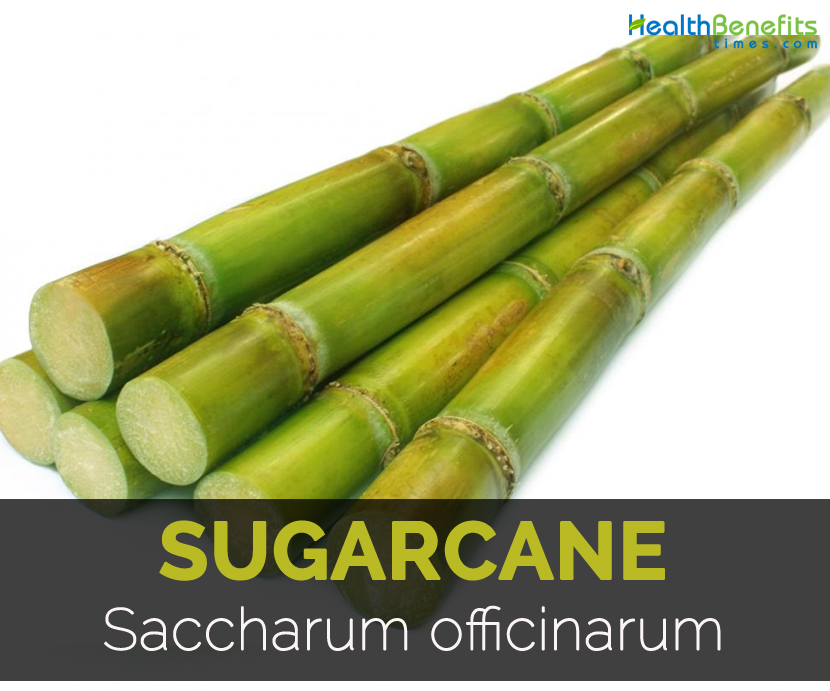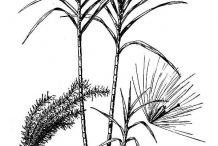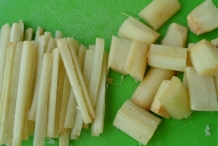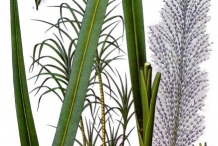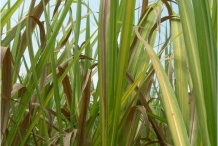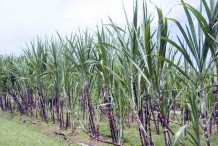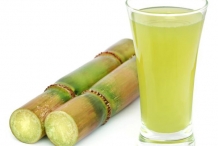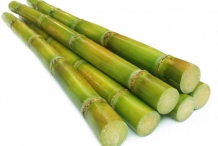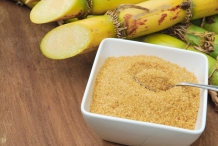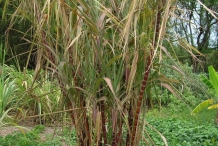| Sugarcane Quick Facts |
| Name: |
Sugarcane |
| Scientific Name: |
Saccharum officinarum |
| Origin |
Sugarcane is originated in Southeast Asia and is also cultivated in tropical as well as subtropical countries worldwide for producing sugar. |
| Flesh colors |
White |
| Taste |
Sweet |
| Health benefits |
Prevent decaying of tooth, Relieves sore throat and flu, Cure for jaundice, Antioxidant activity, Strengthen immune system |
Sugarcane plant grows in tropical and warm climates. Belonging to the family Poaceae, this plant grows upto 2 to 6 meters (6 to 20 feet) tall. Stems are green, purple or pinkish of 5 m high. The plant bears green and elongated leaves of 12 to 24 inches long and 2 inches wide. It bears bisexual flowers. Other common names for sugar cane are Sugar Cane ‘Badila’, Saccharum and Purple Sugar Cane.
It was firstly grown in Asia and after year 700 people started to plant it in Africa and Southern Europe and later it spread to Australia and America. It is also cultivated in Tamil Nadu. Brazil is the biggest producer in South America. The stalks of sugarcane grow from 2 to 6 meters tall. The stalks contain sugar which is used to sweeten drinks and foods. The remaining stalk after sugar has been extracted is burned to generate heat and electricity. It is also used to make cardboard, paper and cutlery. The crop needs high rainfall and high temperature. Alluvial soil or black soil is preferred for this crop. The plant requires high content of water. Compost manure and chemical fertilizers are used as the crop absorbs nutrient matter from soil.
From ancient times, sugarcane is used for chewing to extract sweet juice. In New Guinea, it was cultivated about 8000 years ago. In India, juice was extracted by boiling more than 2000 years ago. Sugarcane and its hybrids are developed for producing sugar, ethanol and other industrial uses in subtropical and tropical regions around the world. The byproducts and stems of sugar industry is used to feed livestock.
History
Sugarcane is native to tropical South and Southeast Asia. The production of crystalline sugar started in Northern India but still the exact date of production of sugar cane is unclear. Earliest evidence shows the production of sugar from ancient Sanskrit and Pali texts. In 8th century, traders of Arab and Muslim introduced sugar from South Asia to other parts of Abbasid Caliphate in Mesopotamia, Mediterranean, Andalusia, Egypt and North Africa.
Firstly Christopher Columbus brought sugarcane to Caribbean during his second voyage to America; firstly to island of Hispaniola. Sugar was shipped from Caribbean to New England or Europe to make rum. Profits from sale of sugar were used to buy manufactured goods which were then shipped to West Africa where they were haggle for slaves. Then slaves brought back to Caribbean to be sold to planters of sugar. Profits earned from sale of slaves were used to purchase more sugar which was consigned to Europe.
In 1823, the plantation of sugar occurred in British colony of Antigua. In 17th through 19th centuries, boiling houses converted juice of sugarcane into raw sugar. In Western colonies, these houses were adhered to sugar plantations. In late 19th century, the plantation of sugar started on island of Reunion.
Slaves were rescued in British Empire after 1833 and many would not work on sugarcane plantations when they had a choice. Therefore British owners of sugarcane plantation required new workers and found cheap labor in Portugal, China and India. The plantation of sugar thrive in Natal, Fiji, Sri Lanka, Burma, British Guiana, Malaysia, Jamaica, Martinique, Trinidad, Guadeloupe, French Guiana, St. Lucia, St. Kitts, St. Vincent, Suriname, St. Croix, Mauritius and Nevis. It is a vital part of economy of Belize, Guyana, Haiti and Barbados along with Guadeloupe, Dominican Republic and Jamaica.
Plant
Sugarcane is a perennial plant which is found in clumps that consists of various strong unbranched stems. A structure of rhizomes form under the soil that sends up secondary shoots near parent plant. Stems vary from green, purple or pinkish reaching upto the height of 5 m (16 ft). It is jointed and nodes are present at the base of alternate leaves. Internodes possess fibrous white pith deeply involved in sugary sap. Leaves are green, linear and elongated with thick midribs as well as saw toothed edges and grow up to 12 to 24 inches (30 to 60 cm) long and 2 inches (5 cm) wide. An inflorescence is a panicle measuring 24 inches (60 cm) long, which a pinkish plume is being broad at base and tapering towards at top. Spikelets are 3 mm long, concealed in tufts of silky, long hair and borne on side branches. The dry fruits contain single seed. The sugarcane is harvested before the flowering starts because the flowering process causes reduction in sugar content.
Health Benefits of Sugarcane
Sugarcane is loaded with antioxidants that help to counteract infections and enhance immunity. It has high content of calcium, magnesium, iron and other electrolytes which is great for dehydration. It is a cure for common cold as well as other infections and also counteracts fever as it enhances the level of body’s protein. An intake of raw sugarcane juice provides various health benefits and is also packed with vital nutrients which are essential for the body. Sugarcane is a base ingredient for molasses, jaggery, rum, ethanol and biofuel. Sugarcane contains high content of Vitamin B2, Vitamin B1, Vitamin C, Vitamin B6 and inorganic salts such as iron, phosphorus, calcium and organic acids such as fumaric acid, succinic acid, citric acid and malic acid.
- Prevent decaying of tooth
Sugar cane and the juice extracted from it help to prevent tooth decay effectively. It has high content of minerals so sugarcane juice helps in prevention of tooth decay and also limits the issue of bad breath. After meals, consume a piece of fragrant sugar cane as a dessert to promote the breath and also avoid tooth decay.
- Relieves sore throat and flu
An intake of one glass of sugar cane regularly prevents the body from illnesses such as colds, sore throats and flu. The people with these problems might be helpful with sugarcane. It also helps to moisturize body and assist to treat diabetes, kidney stones, flu, jaundice, cancer and sore throat.
- Cure for jaundice
Juice of sugar cane helps to treat jaundice. Drink two glasses of sugar cane juice with salt and lemon regularly to speed up the recovery process. It provides high energy that helps to stay energetic the whole day. Add sugar cane juice or sugarcane to the diet to get naturally healthy and beautiful skin.
- Antioxidant activity
Sugarcane juice has high content of phenolic compounds and flavonoids which acts as anticancer, anti-inflammatory, anti-allergic and anti-viral substance. Drink a glass of sugar cane juice when exposed to sun and feel tired. This lowers the heat of the body immediately and re-energizes the body. Though sugarcane juice is loaded with various health benefits, we have to make sure to drink it from a clean source.
- Strengthen immune system
Sugar cane has high content of chromium, calcium, copper, cobalt, manganese, magnesium, potassium, phosphorus and zinc. It has diverse amount of vitamins such as Vitamin C, Vitamin A, Vitamin B2, Vitamin B1, Vitamin B5, Vitamin B3 and Vitamin B6 and other natural nutrients such as antioxidants, chlorophyll, fiber, protein and other unsaturated compounds that are great to maintain overall health. It counteracts against cancer and stabilize levels of blood sugar in patients having diabetes, lower convulsions, fever, rejuvenate stomach, purify kidney, heart, kidneys, brain, eyes and sex organs while lowering bad cholesterol as well as triglycerides in the body and also provide relief from various diseases.
- Moisturize body and skin health
Sugarcane is great for summers when the throat becomes dry due to over sweating and high body heat. Intake a glass of sugar cane juice to make the body hydrated. Moreover, it is also a common benefit of juice extracted from sugar cane. The regular consumption of sugarcane juice clears skin inflammation as well as inflammations and also improves skin appearance and also lowers the signs of aging such as discoloration, blemishes, wrinkles and scars.
- Treat acne
Sugarcane has alpha hydroxyl acid which provides various skin benefits to maintain healthy and beautiful skin. It is used to prevent acne, lower inflammation due to acne, moisturize skin and also prevents aging. Apply sugar cane juice on skin as a face mask of exfoliating creams and apply it to face for smooth and radiant skin naturally at low cost. Apply the clean sugar cane juice to the upper and lower eye lids with clean gauze to lower swollen eyes, eye inflammation and red eye. For prevention of wrinkles, mix two teaspoons of sugar cane juice with turmeric powder and apply this mixture to the skin for several times in a month or 10 minutes for one and rinse off with clean water.
- Cancer prevention
Being an alkaline food, sugar cane juice contains high content of minerals such as magnesium, calcium, iron and potassium. The cancers could not develop in alkaline environments. The results obtained from the study shows that this drink helps to prevent cancer such as breast cancer and prostate cancer.
- Helpful during pregnancy
Sugarcane juice helps to lower swelling and vomiting during pregnancy in many women. Mix the fresh sugar cane juice and ginger and consume it one a day for vomiting during pregnancy. Drink sugar cane juice instead of water for the women who experience mild swelling in few months of pregnancy. It effectively lowers the symptoms of pregnancy and also assists future moms to feel much better. It promotes metabolism, improve digestion, lower symptoms of morning sickness and also provides energy throughout the day. It also eradicates symptoms of constipation.
- Cure diabetes
Sugarcane juice has low glycemic index which is based on sugar types found in juice and is beneficial than soda or average fizzy drink. Sugars are absorbed slowly and processed by the body, prevents sugar rush that many people relate with high glycemic beverages. For the people who does not have type 2 diabetes could help to regulate level of blood pressure when consumed moderate amounts of sugarcane juice.
https://www.youtube.com/watch?v=cuwaVPmGuBQ
Types of Sugarcane
The sugar cane family is comprised of more than 30 sugar cane types. Sugar cane is actually a evergreen grass which multiplies in warm, damp places just like Brazil and India. The sugar produced from sugar cane is utilized in syrups, juices, as well as molasses, however the remaining portion of the plant may also be used in the manufacture of eco-friendly paper items. Although it is hard to search through all the types as well as hybrids of sugar cane, sugar cane could be typically split into three groups according to their functions as well as qualities.
The genus Saccharum has got five essential varieties viz.,
- Saccharum Officinarum,
- S.Sinense
- S.barberi
- S.robustum
- S.spontanuem.
1. Saccharum Officinarum
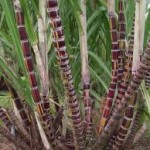 Saccharum Officinarum is a member of the grass family (Poaceae) and is also broadly grown, offering around 70% of the world’s sugar. Sugar cane produces the greatest variety of calories per unit area of cultivation of the plant. The term ‘sugar’ is believed to originate from the ancient Sanskrit ‘sharkara’. Sugar cane most likely originated from New Guinea, and was taken to the Americas by the explorer Christopher Columbus on his second expedition there in 1493. Sugar cane has become cultivated in more than 70 countries, mostly within the tropics, but also in certain sub-tropical areas. India and Brazil develop about 50 % the world’s cane sugar.
Saccharum Officinarum is a member of the grass family (Poaceae) and is also broadly grown, offering around 70% of the world’s sugar. Sugar cane produces the greatest variety of calories per unit area of cultivation of the plant. The term ‘sugar’ is believed to originate from the ancient Sanskrit ‘sharkara’. Sugar cane most likely originated from New Guinea, and was taken to the Americas by the explorer Christopher Columbus on his second expedition there in 1493. Sugar cane has become cultivated in more than 70 countries, mostly within the tropics, but also in certain sub-tropical areas. India and Brazil develop about 50 % the world’s cane sugar.
This is actually the varieties generally referred to whenever we talk about sugarcane. This really is one of the unique grown varieties, even though none of the original officinarums is industrially developed at this time. Numerous officinarum types were under farming ahead of the creation of hybrid types. It really is abundant with sucrose. Its stalks are energetic and also long with lower fiber content. The Dutch scientists called them “noble canes”. It’s got 2n=80 chromosomes. Currently they are cultivated for gnawing objective. They are thicker as well as juicy canes great for chewing purpose also. This varieties consists of the tropical canes native to the New Guinea. These types of canes include higher sugar content, lower fiber and produce higher tonnage. These are typically resistant against smut but they are vulnerable to red rot as well as mosaic illnesses. The cultivation of the species is restricted to exotic areas. However in the past few years these canes have already been succeeded by hybridization among Officinarum, spontaneum and also other varieties in subtropical areas.
2. Saccharum sinense
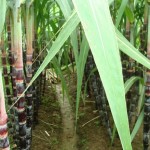 Saccharum sinense is a member of the Saccharum (Sugarcane) family. Its botanical title is Saccharum sinense. Saccharum sinense develops like a evergreen and is also a grass. As being a evergreen plant, it has a tendency to grow best over a number of years (approximately 3 years and greater). Usually grows with a grass habit. Tougher as compared to sugar cane and much more modified to poor soils and dry situations; also leafier, with thin hard canes. Might be grown for fodder in the same manner as napier grass (Pennisetum purpureum Schumach.), yet feed value as well as yields are reduced. Cut for fodder at intervals of 3 to 4 months.
Saccharum sinense is a member of the Saccharum (Sugarcane) family. Its botanical title is Saccharum sinense. Saccharum sinense develops like a evergreen and is also a grass. As being a evergreen plant, it has a tendency to grow best over a number of years (approximately 3 years and greater). Usually grows with a grass habit. Tougher as compared to sugar cane and much more modified to poor soils and dry situations; also leafier, with thin hard canes. Might be grown for fodder in the same manner as napier grass (Pennisetum purpureum Schumach.), yet feed value as well as yields are reduced. Cut for fodder at intervals of 3 to 4 months.
Saccharum sinense is usually thought to be a half robust plant, therefore make sure to safeguard this plant from frosts as well as lower temperature ranges. This is known as “Chinese Cane” since it’s location of origin is central and also South east China. It really is slim stalked with long internodes, and long and narrow leaves. They are lower as well as in sucrose and purity, loaded with fibre and also starch. The chromosome number is 2n=111 to 120. “Uba” is among the significant types under these varieties that was in cultivation in a number of nations. At the moment the species is recognized as inappropriate for industrial farming.
This variety of grown sugarcane is native to north-eastern India. This varieties is characterized by lengthy as well as slim stalks, wide leaves, lower to moderate sucrose content as well as earlier maturation. This variety consists of ‘Pansahi’, ‘Nargori’ and ‘Mungo’ categories of sugarcane. Internodes of these canes are lengthy and much more or even less zigzag and nodes are notable.
3. Saccharum barberi
Saccharum barberi is really an evergreen plant having a short strong rhizome. The numerous vertical canes employ a optimum diameter of 2.5 cm (1 in) along with the leaf blades an optimum width of 5 centimeters (2.0 in). The flower is actually a huge panicle along with lengthy silky hairs about the stalk that soon break off. The spikelet are usually in pairs, one with a shorter stalk and the other without. The canes have got a average sugar along with a higher fiber content. Saccharum barberi originated from northern India and it has been exported to many other regions of the world. At one time it absolutely was the main varieties grown in North America. It requires an increasing temperature of 20 °C (68 °F) to 32 °C (90 °F) and 1,200 to 1,500 millimeters (47 to 59 in) of rain.
This variety derives its title from the scientist Dr.C.A.Barber who explained these types of original canes of subtropical India. This is called “Indian species”. It’s got chromosome numbers 2n=81 to 124. They were under large scale farming within the subtropical India for production of gur and Khandsari sugar. They are more durable as well as disease proof and also have greater sugar as well as fibre contents. They’re thin stalked. The clones of the varieties are extremely resistant to low and high temperature ranges, problem soils as well as water logged conditions. However, due to their inadequate yields, they aren’t under industrial farming at the moment.
This variety can also be native to north-eastern India. It characterized by short mid thin stalks, small leaves, reduced to medium sucrose content, and earlier maturation. This varieties consists of ‘Sarethe’ as well as ‘Sunnabile’ categories of sugarcane. Both the previously discussed species, native to north-eastern India were in farming for a lot of centuries yet now-a-days canes of those species have already been substituted with complicated hybrid clones. Along with the previously mentioned three cultivated species there’s two wild varieties S. spontaneum and S. robustum.
4. Saccharum robustum
This varieties was discovered in New Guinea Islands. The stalks are lengthy, thicker as well as energetic growing. It is abundant with fibre as well as inadequate in sugar. The chromosome number is 2n=60 and 80. This can be a outrageous varieties and not ideal for agricultural manufacturing.
5. Saccharum spontaneum
This really is referred to as “wild cane”. Its forms have different amount of chromosomes (2n=40 to 128). Significant variation is seen in the morphology of the species. Generally the cane is extremely thin and short, the leaves are slim and tough. The plant is extremely strong and resistant against most illnesses. The species just isn’t helpful for sugar manufacturing. The sugar content is suprisingly low. This variety is wonderful for evolving hybrid types especially to get disease and stress proof types.
Instructions
1. Make use of the razor-sharp knife to chop the raw sugar cane stalks to the wanted length. The length would depend on the recipe you’re preparing.
2. Firmly fasten the plastic bags round the ends of the stalks together with the rubber bands. Squeeze out any excessive air.
3. Keep the sugar cane within the vegetable crisper within the refrigerator or even the lowest shelf for approximately a couple weeks.
Avoid:
Avoid product which is soft or even has got spots of mold around the bark. Mold on the ends could be cut-off.
References:
https://www.itis.gov/servlet/SingleRpt/SingleRpt?search_topic=TSN&search_value=42058#null
http://www.stylecraze.com/articles/benefits-of-sugarcane-juice-for-skin-hair-and-health/#gref
https://en.wikipedia.org/wiki/Sugarcane#History
https://www.herbs2000.com/herbs/herbs_sugar_cane.htm
https://www.organicfacts.net/sugarcane-juice.html
Comments
comments


